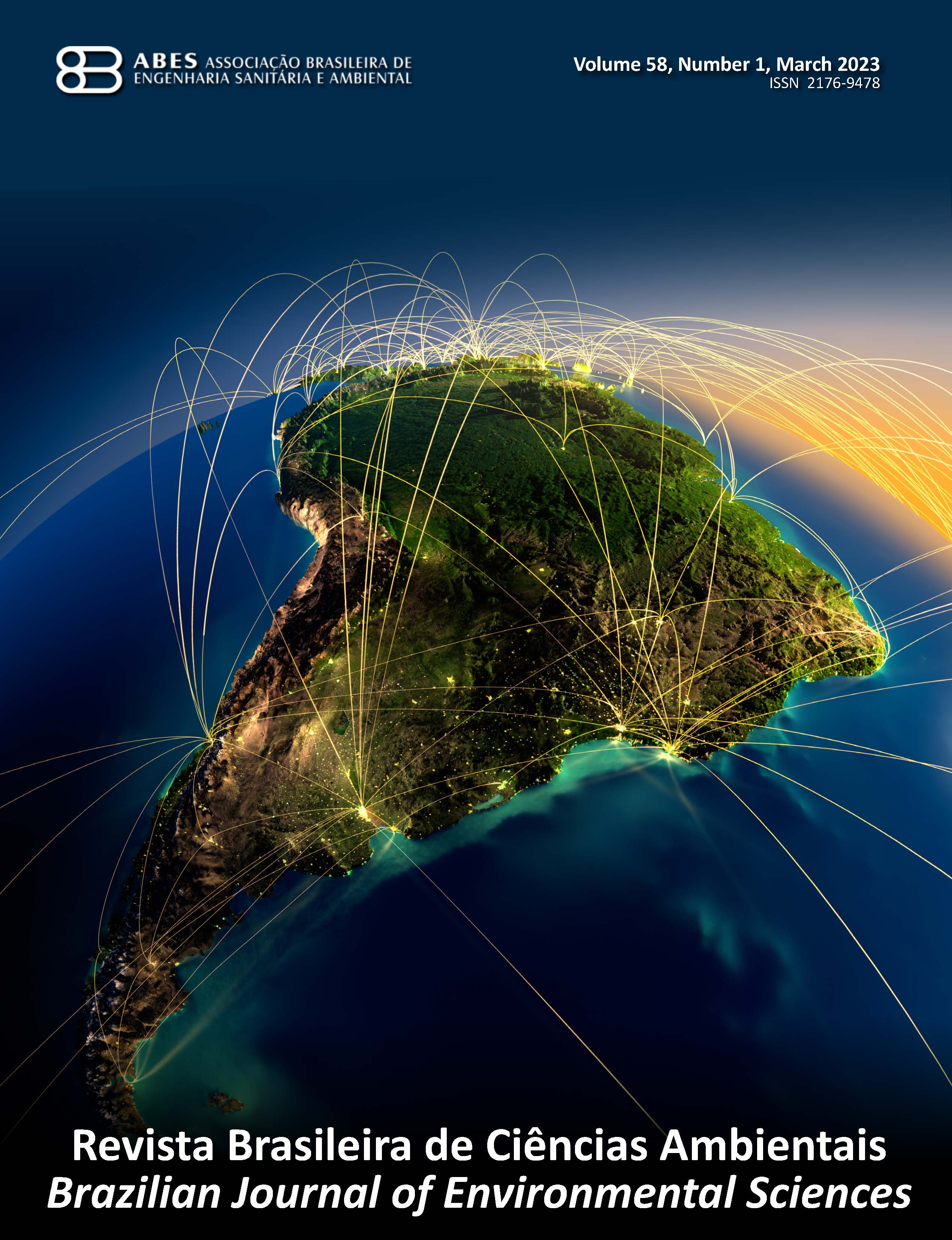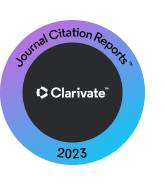Assessment of employing different cloud cover data sources to model the Brazilian solar energy potentiality
DOI:
https://doi.org/10.5327/Z2176-94782451Keywords:
cloud cover; solar radiation; reanalysis data; satellite data; CMIP6 models.Abstract
A simplified atmospheric transmittance model based on the Beer-Lambert law was utilized to analyze surface solar radiation (SSR) variability based on different sources of cloud cover datasets (CMIP6, ERA5, NCEP, ISCCP, and EUMETSAT). This study evaluated the performance of various modeled SSR datasets against observed data from the Brazilian Daily Weather Gridded Data (BR-DWGD) over the period from 1983 to 2009. Contour plots of annual average SSR from the five modeled datasets were compared with BR-DWGD observations, revealing spatial agreements and discrepancies. The highest SSR values were consistently observed in the Brazilian semi-arid Northeast, while the Amazon region exhibited the lowest values. In the analysis of annual averages, the International Satellite Cloud Climatology Project (ISCCP) demonstrated the closest agreement with BR-DWGD, while the National Center for Environmental Prediction (NCEP) showed the most significant deviations. Root mean square error (RMSE) analysis highlighted seasonal variability in model performance, with the Coupled Model Intercomparison Project Phase 6 (CMIP6) and the European Organisation for the Exploitation of Meteorological Satellites (EUMETSAT) performing best during equinoxes, and ISCCP showing the lowest annual RMSE (16.9 Wm⁻²). Hierarchical clustering further grouped EUMETSAT and CMIP6 as the most similar and accurate datasets, while NCEP remained the least consistent. Global horizontal irradiance maps corroborated SSR patterns, with higher values in the Northeast and lower values in the Amazon and Southern regions. These findings underscored the importance of dataset selection for accurate SSR modeling in Brazil, with ISCCP, EUMETSAT, and CMIP6 emerging as the most reliable options.
Downloads
References
Berger, A., 1978. Long-term variations of daily insolation and Quaternary. Journal of Atmospheric Sciences, v. 35 (12), 2362-2367. https://doi.org/10.1175/1520-0469(1978)035<2362:LTVODI>2.0.CO;2.
Bird, R.; Riordan, C., 1986. Simple solar spectral model for direct and diffuse irradiance on horizontal and tilted planes at the earth’s surface for cloudless atmospheres. Journal of Applied Meteorology and Climatology, v. 25 (1), 87-97. https://doi.org/10.1175/1520-0450(1986)025<0087:SSSMFD>2.0.CO;2.
Bird, R.E.; Hulstrom, R.L., 1981. A Simplified Clear Sky Model for Direct and Diffuse Insolation on Horizontal Surfaces. Tr-642-761. Solar Energy Research Institute (SERI)—US Department of Energy, Golden, CO. http://dx.doi.org/10.2172/6510849.
Chakraborty, T.; X. Lee., 2021. Large differences in diffuse solar radiation among current-generation reanalysis and satellite-derived products. Journal of Climate, v. 34 (16), 6635-6650. https://doi.org/10.1175/JCLI-D-20-0979.1.
Collins, M.R.; Knutti, J.; Arblaster, J.-L.; Dufresne, T.; Fichefet, P.; Friedlingstein, X.; Gao, W.J.; Gutowski, T.; Johns, G.; Krinner, M.; Shongwe, C.; Tebaldi, A.J.; Weaver, A. J.; Wehner, M., 2013. Long-term Climate Change: Projections, Commitments and Irreversibility. In: Climate Change 2013: The Physical Science Basis. Contribution of Working Group I to the Fifth Assessment Report of the Intergovernmental Panel on Climate Change [Stocker, T.F.; D. Qin, G.-K. Plattner, M. Tignor, S.K. Allen, J. Boschung, A. Nauels, Y. Xia, V. Bex and P.M. Midgley (eds.)]. Cambridge University Press, Cambridge, United Kingdom and New York, NY, USA. https://doi.org/10.1017/CBO9781107415324.024.
Danso, D.K.; Anquetin, S.; Diedhiou, A.; Lavaysse, C.; Hingray, B.; Raynaud, D.; Kobea, A.T., 2022. A CMIP6 assessment of the potential climate change impacts on solar photovoltaic energy and its atmospheric drivers in West Africa. Environmental Research Letters, v. 17. https://doi.org/10.1088/1748-9326/ac5a67.
Dubey, S.; Sarvaiya, J.N.; Seshadri, B., 2013. Temperature Dependent Photovoltaic (PV) efficiency and its effect on PV production in the world – a review. Energy Procedia, v. 33, 311-321. https://doi.org/10.1016/j.egypro.2013.05.072.
Free, M.; Sun, B.; Yoo, H.L., 2016. Comparison between total cloud cover in four reanalysis products and cloud measured by visual observations at U.S. weather stations. Journal of Climate, v. 29 (6), 2015-2021. https://doi.org/10.1175/JCLI-D-15-0637.1.
Ha, S.; Zhou, Z.; Im, E-S.; Lee, Y-M., 2023. Comparative assessment of future solar power potential based on CMIP5 and CMIP6 multi-model ensembles. Renewable Energy, v. 206, 324-335. https://doi.org/10.1016/j.renene.2023.02.039.
Isaza, A.; Kay, M.; Evans, J.P.; Prasad, A,; Bremner.; S., 2023. Maximizing photovoltaic potential and minimizing costs in a future warmer climate: the role of atmospheric aerosols and greenhouse gas emissions. Renewable Energy, v. 219 (Part 2), 119561. https://doi.org/10.1016/j.renene.2023.119561.
Martins, F.R.; Abreu, S.L.; Pereira, E.B., 2012. Scenarios for solar thermal energy applications in Brazil, Energy Policy. v. 48, 640-649. https://doi.org/10.1016/j.enpol.2012.05.082.
Nwokolo, S.C.; Ogbulezie, J.C.; Ushie, O.J., 2023. A multi-model ensemble-based CMIP6 assessment of future solar radiation and PV potential under various climate warming scenarios. Optik, v. 285, 170956. https://doi.org/10.1016/j.ijleo.2023.170956.
Oliveira, E.D., 2023. Daily INSOLation (DINSOL-v1.0): an intuitive tool for classrooms and specifying solar radiation boundary conditions. Geoscientific Model Development, v. 16 (9), 2371-2390. https://doi.org/10.5194/gmd-16-2371-2023.
Oliveira, E.D.; Fernandez, J.H., 2020. Um novo modelo climático simplificado: global resolved energy balance with galactic cosmic rays (GREB-GCR) theory. Revista Brasileira de Geografia Física, v. 13 (2), 842-854. https://doi.org/10.26848/rbgf.v13.2.p842-854.
Oliveira, E.D.; Fernandez, J.H.; Mendes, D.; Spyrides, M.H.C.; Gonçalves, W.A., 2019. Validação de um modelo climático simplificado adaptado para simular os efeitos do aumento da concentração de CO2 associados à teoria dos raios cósmicos galácticos (Validation of a simplified climate model adapted to simulate the effects of increased CO2 concentration associated with the galactic cosmic rays theory). Revista Brasileira de Geografia Física, v. 12 (3), 768-778. https://doi.org/10.26848/rbgf.v12.3.p768-778.
Pereira, E.B.; Martins, F.R.; Gonçalves, A.R.; Costa, R.S.; Lima, F.L.; Rüther, R.; Abreu, S.L de.; Tiepolo, G.M.; Pereira, S.V.; Souza, J.G., 2017. Atlas Brasileiro de Energia Solar. 2. ed. INPE, São José dos Campos, 80 p. https://doi.org/10.34024/978851700089.
Silva, O.A.V.O.L.; Moita Neto, J.M.; Lira, M.A.T.; Morais, F.H.M., 2021. Expansion of photovoltaic systems in multicampi higher education institutions: evaluation and guidelines. Revista Brasileira de Ciências Ambientais (RBCIAMB), v. 56 (4), 697-709. https://doi.org/10.5327/Z217694781009.
Souza, R.M.A.; Leitão, M.V.B.R.; Oliveira, G.M.; Oliveira, E.D.; Correia, L.T., 2021. Demanda hídrica e adubação orgânica no cultivo protegido de pimentão na região norte da Bahia. Irriga, v. 26 (4), 787-800. https://doi.org/10.15809/irriga.2021v26n4p787-800.
Vunnam, S.; VanithaSri, M.; RamaKoteswaraRao, A., 2021. Performance analysis of mono crystalline, poly crystalline and thin film material based 6 × 6 T-C-T PV array under different partial shading situations. Optik, v. 248, 168055. https://doi.org/10.1016/j.ijleo.2021.168055.
Wang, Z.; Lin, L.; Xu,Y.; Che, H.; Zhang, X.; Zhang, H.; Dong, W.; Wang, C.; Gui, K.; Xie, B., 2021. Incorrect Asian aerosols affecting the attribution and projection of regional climate change in CMIP6 models. npj Climate and Atmospheric Science. v. 4 (2). https://doi.org/10.1038/s41612-020-00159-2.
Wild, M.; Folini, D.; Henschel, F.; Fischer, N.; Müller, B., 2015. Projections of long-term changes in solar radiation based on CMIP5 climate models and their influence on energy yields of photovoltaic systems, Solar Energy, v. 116, 12-24. https://doi.org/10.1016/j.solener.2015.03.039.
Wild, M.; Gilgen, H.; Roesch, A.; Ohmura, A.; Long, C.N.; Dutton, E.G.; Forgan, B.; Kallis, A.; Russak, V.; Tsvetkov, A., 2005. From Dimming to Brightening: Decadal Changes in Solar Radiation at Earth's Surface. Science, v. 308 (5723), 847-850. https://www.science.org/doi/10.1126/science.1103215.
Wu, H.; Xu, X.; Luo, T.; Yang, Y.; Xiong, Z.; Wang, Y., 2023. Variation and comparison of cloud cover in MODIS and four reanalysis datasets of ERA-interim, ERA5, MERRA-2 and NCEP, Atmospheric Research, v. 281, 106477. https://doi.org/10.1016/j.atmosres.2022.106477.
Xavier, A.C.; Scanlon, B.R.; King, C.W.; Alves, A.I., 2022. New improved Brazilian daily weather gridded data (1961–2020). International Journal of Climatology, v. 42 (16), 8390-8404. https://doi.org/10.1002/joc.7731.
Downloads
Published
How to Cite
Issue
Section
License
Copyright (c) 2025 Revista Brasileira de Ciências Ambientais

This work is licensed under a Creative Commons Attribution 4.0 International License.

























